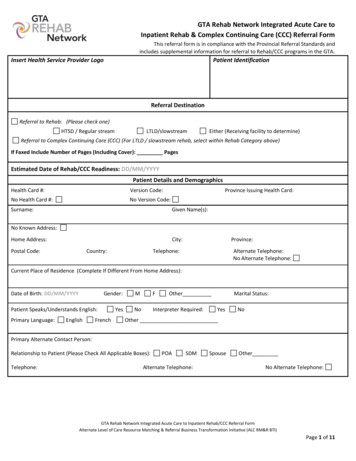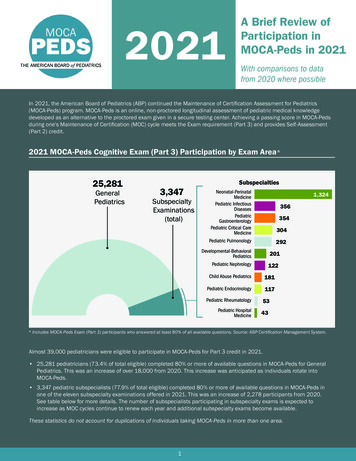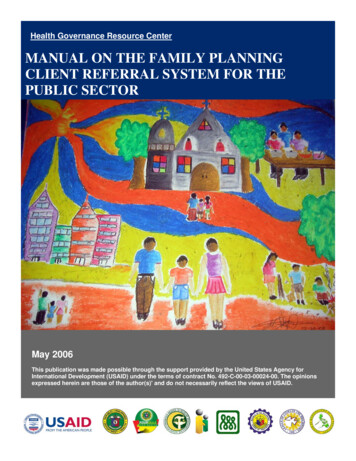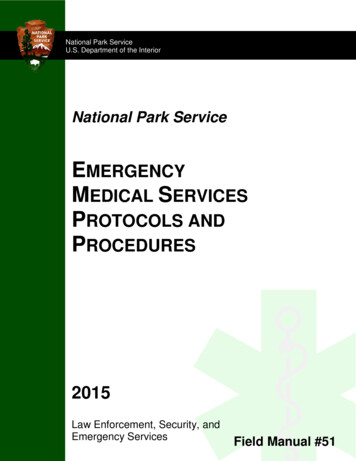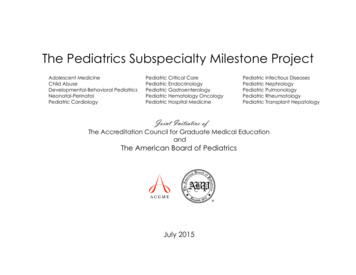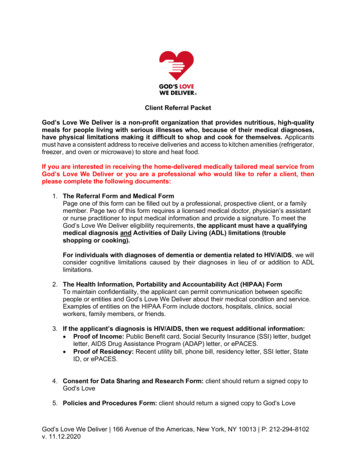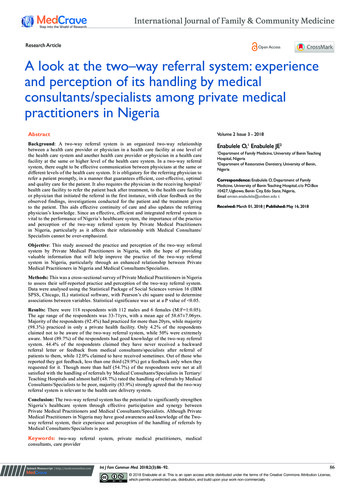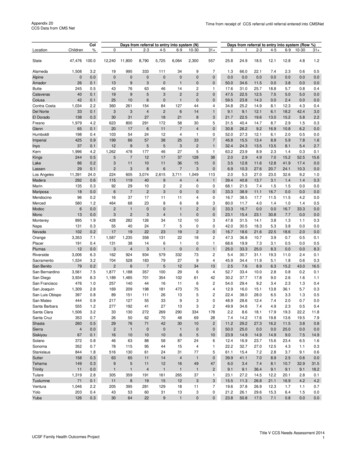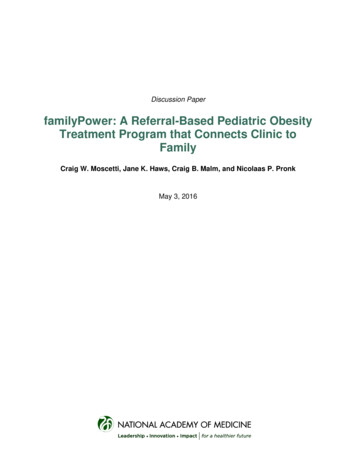
Transcription
Discussion PaperfamilyPower: A Referral-Based Pediatric ObesityTreatment Program that Connects Clinic toFamilyCraig W. Moscetti, Jane K. Haws, Craig B. Malm, and Nicolaas P. PronkMay 3, 2016
familyPower: A Referral-Based Pediatric Obesity TreatmentProgram that Connects Clinic to FamilyCraig W. Moscetti, M.P.H, Allina Health; Jane K. Haws, R.N., M.B.A., HealthPartners, Inc.;Craig Malm, M.B.A., Allina Health; Nicolaas P. Pronk, Ph.D., FACSM, FAWHP,HealthPartners, Inc.INTRODUCTIONOverweight and obesity, and their negative sequelae, have become the focus of policy makers,business leaders, health care systems, and the general public in the United States and globally.Currently, one in three children and adolescents in the United States is either overweight orobese (Ogden et al., 2014). Children who are overweight or obese tend to remain as such intoadulthood, increasing their risk of developing associated chronic conditions, such as type 2diabetes, cardiovascular disease, nonalcoholic fatty liver disease, and other cardio-metabolicproblems (Slomski, 2014). Further, more research is suggesting an important link betweenphysical and mental health, with similar risk factors between obesity and chronic disease (e.g.,unhealthy diet, physical inactivity, poor sleep) and many mental disorders, such as depression,anxiety, and attention deficit hyperactivity disorder (ADHD).Obesity is a major driver of current health care expenditures. Current estimates rangefrom 147 billion to nearly 210 billion per year (Cawley and Meyerhoefer, 2012). Medical costsare often higher for patients who are overweight or obese. For example, costs for providingemergency room care to a patient presenting with chest pains are 28 percent higher for obesepatients and 22 percent higher for overweight patients compared to those of normal weight(Peitz et al., 2014).During the past 2 decades, the prevalence of obesity among children steadily increased(Fryar et al., 2014). From 1976 to 1980, the prevalence of obesity was 5 percent among 2- to 5year-olds, 6.5 percent among 6- to 11-year-olds, and 5 percent among 12- to 19-year-olds. Adecade later, in 1999–2000, prevalence more than doubled for all age groups to 10.3 percent,15.1 percent, and 14.8 percent, respectively. Another 10 years later, in 2009–2010, theprevalence of obesity continued to increase, albeit at a slower rate, to 12 percent for 2- to 5year-olds, 18 percent for 6- to 11-year-olds, and 18.4 percent for 12- to 19-year-olds.Recent national surveys, however, have indicated that obesity prevalence may beleveling off among certain age groups, in particular young children ages 2 to 5 years of age.Recently, the Centers for Disease Control and Prevention (CDC) reported that 18 states and 1territory experienced statewide declines in the prevalence of obesity among low-income childrenages 2–5 years between 2008 and 2011 (CDC, 2013). Less promising, this progress has comeat the same time as an increased prevalence among both male and female adolescents ages12 to 19.However, despite the overwhelming recognition of obesity as a critical economic andpublic health issue, and the top child health concern of parents (C.S. Mott Children’s Hospital,2015), researchers, policy makers, and public health and health care practitioners continue tosearch for the most effective and sustainable interventions to address the issue. A variety ofsectors have a stake in solving the obesity epidemic. As such, solutions will require engagementfrom a wide range of actors, such as public health, health care, business and industry,education, agriculture and the food industry, transportation and urban planning, philanthropy,1
the nonprofit sector, and academia, as embodied by the Roundtable on Obesity Solutions1 ofthe National Academies of Sciences, Engineering, and Medicine.CHILDHOOD OBESITY IN MINNESOTAIn Minnesota, roughly 1 in every 5 students in the ninth grade, or 22 percent, is eitheroverweight or obese (Minnesota Department of Education et al.,n.d.). This figure has remainedstable since 2007. Among low-income children between 2 to 5 years old, obesity prevalencehas declined since 2000 from 13.1 percent to 12.6 percent (Trust for America’s Health, 2015).However, this figure is still higher compared to the majority of other states. A considerablegender gap also exists among Minnesota children, with males continuing to be more than twiceas likely to be overweight or obese compared to their female classmates. However, high schoolmales often underestimate their perceived weight status compared to their actual weight status(Minnesota Student Survey Interagency Team, 2013b). In other words, many overweight orobese high school males often perceive themselves to be of normal weight. Among ninth gradeboys in Anoka County, for example, there is an 11 percentage point difference between theprevalence of overweight and obesity and perceived overweight or obesity. Conversely, thetrend is the opposite among females, who tend to overestimate their perceived weight statuscompared to their actual weight status.Unhealthy behaviors linked to overweight and obesity are also common amongMinnesota teens, such as limited fruit and vegetable intake, sugar-sweetened beverage (SSB)consumption, and insufficient physical activity (Minnesota Department of Education et al., n.d.).For example, less than 20 percent of Minnesota ninth graders report consuming five or moreservings of fruit, fruit juice, or vegetables the previous day (Minnesota Department of Health andHealthy Minnesota Partnership, 2012). Similarly, only about half of ninth grade students reportbeing physically active for 30 minutes or more in 5 of the previous 7 days (MinnesotaDepartment of Health and Healthy Minnesota Partnership, 2012). This figure has remainedrelatively stable since 1998.Treatment of pediatric obesity is unlikely to be successful when clinical approaches donot involve parents or consider the family situation (Sung‐Chan et al., 2013). However, thechallenges associated with connecting the clinical interactions between the physician, child, andparents with the family context in addressing obesity are complex. Useful case examples of howclinical efforts can support family-based approaches to treat pediatric obesity are scarce. Thisdiscussion paper offers an example in this area and describes the experiences of a pediatricobesity treatment pilot program implemented as part of collaboration between two health caresystems in Minnesota. We take a case study approach, analyzing the program using the PIPEImpact Metric, and discussing several strategic and implementation challenges to inform theneed for new and innovative models of care and population health.A PARTNERSHIP MODEL TO ADDRESS COMMUNITY NEEDSThe Affordable Care Act (ACA) provided the impetus for health care organizations to reevaluatetheir care delivery models, particularly in how to elevate prevention and better manage chronicdiseases. Much of this shift has stemmed from increased recognition of the limits of clinicalinterventions to promote health. A wide body of public health research supports the notion thatthe majority of factors influencing health are beyond the walls of the clinic. These nonclinicalfactors, known as the social determinants of health, also strongly influence the health anddevelopmental trajectory of children and adolescents (Viner et al., 2012). As such, ies/Nutrition/ObesitySolutions.aspx (accessed April 26, 2016)2
health requires more than disease-oriented clinical interventions focused on treatment andmanagement (Secretary’s Advisory Committee on National Health Promotion and DiseasePrevention, 2010). Instead, health care organizations have the opportunity to improve their caredelivery models through the deployment of a more integrated, collaborative team of health careprofessionals, such as dieticians, nurse practitioners, social workers, psychologists, and healthcoaches (Dietz et al., 2015). Further, partnership opportunities exist across health systems toimprove population health outcomes.One area ripe for collaboration is in the area of care delivery innovation. One suchexample is the Northwest Metro Alliance, a long-term collaboration between Bloomington,Minnesota-based HealthPartners and Minneapolis-based Allina Health that is focused onachieving the Triple Aim of health care (high-quality care, exceptional patient experience, andaffordability) for more than 300,000 people receiving care from these organizations in thenorthwestern suburbs of the Minneapolis-St. Paul metropolitan area. The Northwest MetroAlliance, which was launched in 2010, is a learning lab for an Accountable Care Organization(ACO), modeling many of the rules that are being promulgated by the U.S. Department ofHealth and Human Resources.FAMILYPOWER: TREATING PEDIATRIC OBESITY THROUGH HEALTHY LIFESTYLECOACHINGRecognizing pediatric obesity as a major public health risk and potential driver of future healthcare costs across both health care systems, Allina Health and HealthPartners launchedfamilyPower in 2012 under the Northwest Metro Alliance.2 The familyPower program is a free,voluntary, family-based health coaching referral program to promote healthy behaviors and treatobesity among children 5 to 12 years old. At the time it was launched, providers saw a clearneed for patient and family resources to help address this expanding health issue. As part oftheir regular assessment of patients for obesity (Barlow, 2007), an increasing number ofchildren were presenting with a body mass index (BMI) in excess of the 85th percentile for ageand gender in Anoka County, the primary service area for the Northwest Metro Alliance.Recent data from Anoka County reinforce this observation and underscore the need forearly intervention. Among eighth graders in Anoka County, 22 percent of males and 18 percentof females were overweight or obese in 2013 (Minnesota Student Survey Interagency Team,2013a). Most concerning, however, is an increasing prevalence of overweight and obesitybetween grades 8 and 11. This trend is particularly clear among males, with prevalenceincreasing 5 percentage points during this time period from 22 percent to 27 percent (MinnesotaStudent Survey Interagency Team, 2013a). Many of these pediatric patients also had diagnosedcomorbidities.Despite the clear demand, however, a program or resource did not exist to refer patientsto, and providers themselves did not have either the time or the skill set required to help thechildren and their parents or guardians make meaningful and sustainable lifestyle changes.After constructing an advisory panel of representatives from both organizations, includingpediatricians, clinic leadership, and behavior change experts, the group developed a pilotprogram that would meet the immediate need of pediatricians and the long-term need ofchildren and their families. Program development began in January 2012, and familyPowerbecame operational in August 2012. The initial pilot spanned 3 years (2012–2015), andfollowing commitment from both Allina Health and HealthPartners, the program is planned tocontinue through 2017.2Throughout this paper, “we” refers to the authors, as they represent their respective organizations aspart of the Northwest Metro Alliance.3
Key Programmatic ElementsReferral BasedThe familyPower program was designed to leverage the unique role of health care providersand apply known evidence-based behavior change concepts to support the adoption of severalkey healthy behaviors. The program was launched in cooperation with one Allina Health clinic(Coon Rapids, Minnesota) and one HealthPartners clinic (Andover, Minnesota). Since, theprogram has expanded to include three additional HealthPartners clinics and three additionalAllina Health clinics in the northwest metro region outside of Minneapolis for a total of eightcurrent referring clinics (Figure 1).FIGURE1 AllinaHealthand andHealthPartnersparticipatingin familyPower.FIGURE1 AllinaHealthHealthPartnersclinics clinicsparticipatingin familyPower.The program’s workflow initiates with a care provider referral. Because familyPowerinvolves two separate health systems, referral mechanisms are unique to each health system toensure privacy and protection of personal health information. For one system, referrals aremade directly through the electronic medical record (EMR). The health coach subsequentlyreceives the referral electronically via secure email within the organization’s firewall. The otherhealth system uses a fax-based system, with the necessary patient and parent informationbeing faxed directly to the health coach. The health coach subsequently provides feedback tothe referring provider throughout the process, from outreach to program completion ortermination, to inform future care to ensure patient satisfaction, quality of care, and healthoutcomes—the Triple Aim (Pronk et al., 2013). In essence, the health coach acts as anextension of the care team, with training in public health, psychology, and behavior change.With more patient interaction time than in a clinical setting, the health coach is better positionedto consider and address a patient’s lifestyle, environment, and other social determinants ofhealth. Figure 2 depicts a schematic of the workflow.4
FIGURE 2 Schematic of familyPower workflow and program implementation.Family and Home BasedThe familyPower program uses a one-on-one family- and home-based coaching approach toencourage healthy behavior change. After a referral, the health coach then conducts up to threeoutreach phone calls, the first of which occurs within 1 to 2 business days of the referral. Duringthese outreach calls, the health coach explains the program to the parent or guardian, answersquestions, determines if the family would like to enroll, and schedules an initial in-homecoaching session and assessment.Coaching is offered for up to 1 year, free of charge, and is conducted in-person for thefirst 1 to 3 sessions, followed by telephonic or virtual (e.g., Skype or email) encountersthereafter. In-person sessions are typically conducted in the family’s home, but families alsohave the option to meet at their clinic. The frequency of coaching encounters is variable anddetermined by each family’s preferences. Health coaching is offered for the entire family,recognizing the importance of familial support in modeling healthy behaviors and creating anenabling environment for sustainable behavior change (Bandura, 2001).The home-based nature of the coaching allows the health coach to experience andconsider a wider variety of factors that might otherwise go unnoticed through a telephonic orvirtual consultation. The home visit provides the health coach the opportunity to observe thefamily’s physical home environment: is it a single-family home or an apartment, are there nearbyrecreation areas and grocery stores, and are sidewalks are available. The health coach alsoevaluates the family’s psychosocial environment and the family’s readiness to address differenthealth behaviors. Such understanding is key to the health coach being able to contextualize thesocial determinants influencing the health of the child and tailor the coaching accordingly.Combining Lifestyle Medicine and Coaching for Behavior ChangeHealth coaching is personalized, with a focus on identifying unique obstacles and challenges tohealthy behavior adoption and using motivational interviewing techniques to promote intrinsicmotivation and self-efficacy. After obtaining written consent from the parent or guardian duringthe first session, the health coach conducts an assessment of current obesity-related healthbehaviors and environmental factors to identify challenges and elucidate areas for specificbehavior change goals. Subsequent sessions focus on incrementally identifying and assessingactionable steps to achieve individual goals. This type of tailored approach “meets individualswhere they are.” Goals are incremental to allow families to build momentum in their selfconfidence. The goal is to help steer families down a particular path while allowing them todetermine the pace. In essence, “Successful coaching takes place when coaches apply clearlydefined knowledge and skills so that clients mobilize internal strengths and external resourcesfor sustainable change” (Jordan et al., 2015).The familyPower program uses coaching to facilitate behavior change because of thestrong evidence demonstrating intrinsic motivation and self-efficacy as key factors for behavior5
modification. This has been shown across a wide variety of social science disciplines (Ryan andDeci, 2000). Weight loss outcomes in particular have been found to be strongly linked to selfefficacy (Burke et al., 2015; Byrne et al., 2012; Linde et al., 2006). Further, research has alsoshown perceived self-efficacy among adolescents to predict adoption of healthy behaviors, suchas physical activity (Park and Kim, 2008).Health and wellness coaching has become increasingly common in primary care andcommunity-oriented public health programming. Today’s major public health challenges—whether this refers to obesity prevention or chronic disease management—are complex in theiretiology and interventions, often requiring environmental approaches complemented byindividual-based behavior change. Health care organizations have embraced this notion,recognizing the need to link clinical care with community interventions to improve individual andpopulation health. Health coaches are well versed in the science of major public health issues,but artfully apply counseling, motivational interviewing, and other psychological techniques toidentify individual or environmental barriers to optimal health and well-being, and support clientsin achieving self-determined goals.Healthy Behavior FocusThough weight is the primary health outcome of interest, familyPower’s focus is to promoteadoption or strengthening of weight-related health behaviors. The program uses the 5-2-1-0framework as an overarching model for goal-setting and behavior change, simultaneouslytargeting multiple weight-related behaviors. A recent review by Seburg et al. (2015) found thistype of a multipronged approach to be a key element of primary-care-based childhood obesityprevention and treatment interventions. The 5-2-1-0 framework encourages the adoption ofhealthy behaviors related to healthy eating, physical activity, and screen time. It encourages fiveor more servings of vegetables and fruit per day; 2 hours or less of screen time per day,including television, computer, smartphones, and video games; 1 of more hours of active playper day; and zero sugary drinks. Families also receive a tracker, a tool used both to monitorprogress and for accountability, another important element of successful obesity prevention andtreatment interventions. Coaching is then tailored within the 5-2-1-0 framework, identifyingunique challenges, goals, and action steps.Framework to Guide Program Design and EvaluationConsidering the practice-based context in which the familyPower program is beingimplemented, we applied a framework created in the practice setting at our organizations to thelogic of program design and evaluation (Pronk, 2003). We used the four S’s of programdesign—size, scope, scalability, and sustainability—to design the program. We use thePenetration, Implementation, Participation, and Effectiveness (PIPE) Impact Metric to evaluatethe program. The two represent a framework organized around a few, critical features ofprogram design and evaluation variables that are linked so as to provide opportunities forimprovement based on feedback.Using the four S’s and the PIPE Impact Metric framework, we analyzed familyPower’sprogram design and implementation phases to assess its strengths, limitations, and its potentialeffect upon the community.The four S’s of program design are defined as follows: (Effect) size—The magnitude, extent, relative aggregate amount, or dose of theintervention that affects the user, thereby creating the desired outcomeScope—The range of program operations and activities6
Scalability—The ability of a program to grow or expand to accommodate increasingreach or demand of that programSustainability—The long-term, ongoing support for a program that generates revenue orbenefits through a predictable supply of requisite inputs: time, money, and humanresourcesThe elements of the PIPE Impact Metric—penetration, implementation, participation, andeffectiveness—each represent an equally important aspect of program activation. These fourelements can be further divided into two groupings. Penetration and implementation focus onthe investment required to bring a program to a user; whereas, participation and effectivenessreflect the extent to which the program meaningfully engages users to achieve the desiredoutcome. Combined, these elements shed light on potential program impact. The four elementsare defined as follows: Penetration—The proportion of the target population reached with invitations to engagein the program or interventionImplementation—The degree to which the program has been implemented according toits design specifications and work planParticipation—The proportion of individuals who enroll in the program according to theprogram protocolEffectiveness—The rate of successful participations, with success defined in the originaldesign phase of the intervention and linked to an anticipated health benefitThe Four S’s Applied to familyPower: Program Design and Analysis(Effect) SizeEffect size is considered in the context of the goals and objectives of the familyPower program:(1) the promotion of health behaviors and (2) the treatment of excess weight. As such, effectsize is applied to data that reflects the impact on behavioral outcomes considered by theprogram, such as physical activity, healthy eating, screen time, and self-efficacy. In addition, wewere interested in changes in weight status as measured by BMI.ScopeThe scope of familyPower includes a set of tools and services for creating benchmark, goalsetting, education, action, and accountability. Benchmarking —A standardized assessment is completed at four time intervals: duringthe home visit (i.e., enrollment), 6 months into the program, 12 months into the program,and again at 6 months after program completion (18 months from enrollment).Constructs include self-reported biometric information; previous weight loss intention andsuccess; behavior patterns related to nutrition, physical activity, and screen time; andself-efficacy. The assessment was designed to evaluate how the family is doing withmeeting the 5-2-1-0 behaviors and how the health coaching is affecting their ability tomeet these goals over the course of their time in the program.Goal-Setting, education, and action planning—The program’s health coach is integral toits success and effectiveness. This individual is responsible for program management,education with families on obesity-related topics, and conducting in-person andtelephonic or virtual coaching to set goals and develop individualized action plans in7
partnership with families. Where appropriate, the coach also serves as a connector toother community resources. Coaching sessions usually occur monthly, though theintervals are based on the preference of the family, and are 15–90 minutes in duration.Typically, the first few sessions are more in-depth because of the importance ofestablishing trust between the health coach and family and establishing achievable goalsfrom the outset. Subsequent sessions are by phone or email and often decline induration once an action plan has been established. Goal setting is iterative, identifyingpositive, attainable steps throughout the program based on the families’ uniquecircumstances, challenges, and readiness, and building on each other as the familydevelops confidence and progresses through the program. Sessions are conducted withone or both parents and the child. Families also receive weekly health tips via email onhealthy eating, physical activity, and screen time.Tracking and accountability—During the initial in-home session, each family receives aweekly tracker, a tool designed to assess progress and achievement of the 5-2-1-0behaviors on a daily, weekly, and annual basis. Families can also customize the trackerby adding their own unique goals within the overarching 5-2-1-0 framework. The trackerprovides accountability for families in their efforts to modify behaviors, as well as afeedback mechanism for both the health coach and family. For the coach, feedbackinforms future coaching and goal-setting activities. For the family, the tracker provides amechanism to prioritize behavior changes and build self-efficacy through successfulachievement of goals.Care coordination—Through the time a family is enrolled in familyPower, the healthcoach provides regular feedback to their provider through EMR or email to help informfuture care.Training—familyPower also aims to build the knowledge base among pediatricians inpublic health and lifestyle factors that influence clinical chronic disease and obesitytreatment, management, and care.ScalabilityThe scale of the project was defined up front based on resources available. The familyPowerprogram was intentionally integrated into clinical care delivery to bring public health resourcesas close to the provider as possible. As such, scalability within existing referral clinics isinfluenced by successful screening and marketing to enroll eligible patients into the program.The future scalability of familyPower is dependent upon a number of factors. First, itsexpansion or modifications will be linked to the learnings from this case study, alongside thecontinuous feedback and input from providers, community partners, and the program’s advisorycommittee. Second, scalability is also constrained by availability of dedicated financial andhuman resources for the project, especially, but not limited to, the area of health coaching.Third, the formal collaboration between HealthPartners and Allina Health is only for the TwinCities northwest metropolitan area, rather than the entire service areas of both health systems.However, both health systems present considerable opportunities to replicate the program inother locations. At present, only four of Allina Health’s 90 clinics and four of HealthPartners’ 55primary care clinics refer patients to the familyPower program. Lastly, familyPower relies on ahome-based, one-on-one coaching model as its primary intervention. Though effective in somecases, such an approach is resource intensive on the part of the health coach compared toother technology-based behavior change strategies, such as text messaging or mass media.Hence, scalability issues and concerns need to consider creative use of human resources andthe optimal deployment of technology.8
SustainabilityThe referral-based design of familyPower offers a sustainable delivery model that leverages theunique role of health care institutions and pediatricians. First, families and individuals stillrecognize health care providers as trusted community institutions and important sources ofhealth information. This remains true despite the proliferation of Internet health informationsources (Hesse et al., 2005). Second, children and parents often develop a long-termrelationship with their pediatrician or health care provider. As stated in recent AmericanAcademy of Pediatric guidelines, this unique relationship allows providers to follow children overa long period of time, sometimes from fetal life through college, giving them a unique long-termperspective in preventing chronic conditions such as obesity (Daniels et al., 2015). Allina Healthand HealthPartners have also incorporated routine clinical screening measures, such as height,weight, and BMI, to inform this longitudinal perspective. Based on data collected over time,pediatricians can then assess obesity risk in accordance with the U.S. Preventive Services TaskForce (2010) guidelines that recommend clinicians screen children aged 6 years and older forobesity. Third, by providing regular feedback to providers regarding the progress of clients, thefamilyPower health coach can inform future clinical intervention and care (Yun et al., 2015).However, a key contingency for sustaining familyPower is the institutional commitment by AllinaHealth and HealthPartners to continue its formal collaboration and to financially support theadministration of the program. This also relates to the future of ACOs and the potential of newlyintroduced ideas such as the Accountable Health Communities.Program Impact Analysis Using the PIPE Impact MetricPenetrationTo assess the penetration of familyPower, we assessed total referral volume within the contextof the total and pediatric populations in the cities with familyPower referring clinics. According to2010 Census data, the total population of the six Minnesota cities with familyPower-referringclinics was 178,949, with about 35,446 children aged 5 to 18 years old, roughly 20 percent.Though this pediatric composite includes a broader age range compared to the age criteria forfamilyPower and does not account for individuals who may access health care in a city differentthan the one in which they reside, this figure provides a rough estimate of the potential servicearea for familyPower. Using the statewide prevalence of overweight and obesity among childrenages 11 to 17 (27.2 percent), we estimate the total number of eligible individuals forfamilyPower to be 9,641 (Table 1).Between August 2012 and September 30, 2015, a total of 330 referrals were made forfamilyPower, representing 3.42 percent of all overweight and obese children and adolescents 5to 18 years old in the program’s primary catchment area (Table 1). Referrals peaked in 2013, at115, the first fu
FAMILYPOWER: TREATING PEDIATRIC OBESITY THROUGH HEALTHY LIFESTYLE COACHING Recognizing pediatric obesity as a major public health risk and potential driver of future health care costs across both health care systems, Allina Health and HealthPartners launched familyPower in 2012 under the Northwest Metro Alliance.2 The familyPower program is a free,
